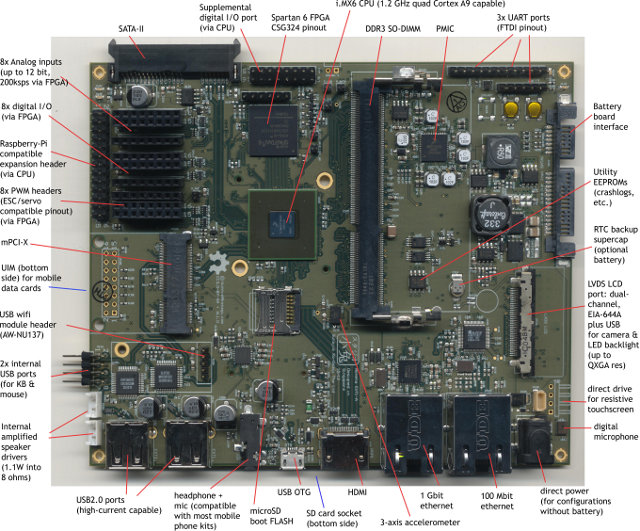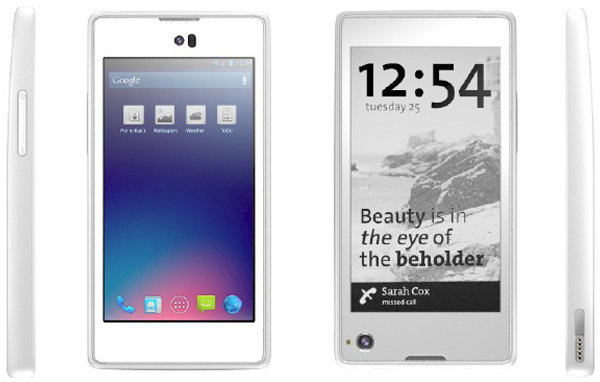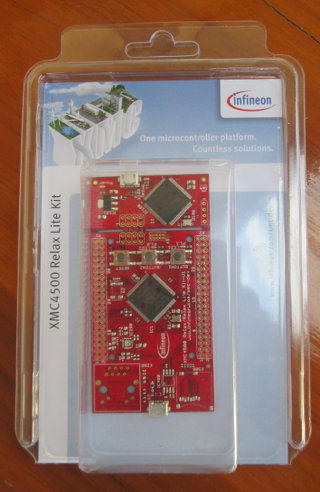Andrew Huang (“Bunnie”) and others have been working on an open source laptop based on Freescale i.MX6 Quad processor since June, and they’ve recently got the motherboard. Beside featuring a powerful quad core ARM processor, the design files are also provided, so if you have the right skills and resources you can build it yourself. The open source laptop mainboard (Codename: Novena) has the following specifications: SoC – Freescale iMX6 Quad @ 1.2GHz with Vivante GC2000 GPU System Memory – 64-bit DDR3-1066 SO-DIMM, upgradable to 4GB Storage – microSD boot flash, SATA-II connector for hard drive / SSD, SD card reader and serial EEPROM (for storing crash logs and other bits of handy data). FPGA – Spartan-6 CSG324. It has several interfaces to the CPU, including a 2Gbit/s RAM-like bus. Internal ports & sensors: mini PCI-express slot UIM slot for mPCIx mobile data cards Dual-channel LVDS LCD connector (up to […]
SliTaz armhf: 46MB Linux Distribution for Raspberry Pi
SliTaz armhf is a minimal Linux distribution based on SliTaz Linux, that uses the hard-float ABI for the Raspberry Pi. The compressed SD card image is 46M, the rootfs 18.6 MB, and Slitaz uses just about 7 MB RAM after boot. Slitaz armhf rootfs comes pre-loaded with the following packages: busybox 1.20.2 dropbear 2012.55 – Light SSH client and server. nano 2.2.6 – GNU Nano Text Editor. retawq 0.2.6c – Text mode Web browser. tazpkg 5.0 – SliTaz packages manager (Tiny autonomous zone packages manager). ytree 1.97 – file manager for file and archives. Slitaz armhf comes with tazpkg package manager which allows to install packages just like you would do with apt-get in Raspbian. There are over 3,300 packages available for Slitaz (x86), and for now, over 250 packages are available for Slitaz armhf. Let’s get try it out. First, download slitaz-armhf-mini-2012-12-14.zip, extract it, and copy it to an […]
YotaPhone Dual Display (LCD + E-Ink) Smartphone Hands-on Video
In the last few days, there has been a lot of buzz about the YotaPhone, an upcoming Russian Android 4.2 smartphone featuring Snapdragon MSM8960 dual core processor with 2 GB RAM and 32/64 GB Flash. But the real innovation is the presence of 2 full 4.3″ displays: a standard LCD display on one side, and an E-Ink display on the other. Here are the preliminary specifications of the YotaPhone: SoC – Qualcomm Snapdragon S4 MSM8960 dual core Krait processor @ 1.5 GHz System Memory – 2GB RAM Storage – 32 or 64 GB NAND Flash Display 4.3″ LCD Display (1280×720) 4.3″ E-Ink EPD display Camera – 12MP front camera Connectivity Wi-Fi (Direct) Bluetooth NFC 2G, 3G and 4G (LTE) mobile networks Audio – 3.5mm headphone jack Battery – 2100 mAh. The device supports wireless charging. Dimensions – 67 x 131 mm Weight – 140 grams You may think a smartphone […]
Running Ubuntu in Android with ODROID-X Development Board
I’ve had several people asking me about running Linux on Android in the last few months, but I did not look into it into details, because I thought we would just be able to run server apps. That is until Rohith left a comment on CNX Software Facebook timeline, that it’s possible to run Linux in Android, and access the user interface via VNC (sort of simple, but I did not think of it). You probably need at least 1GB of memory and a multi-core processor to run this sort of setup correctly, so I finally decided to give it a try by running Ubuntu 12.04 with Unity interface in ODROID-X development board. I mainly followed the instructions available at http://linuxonandroid.org/ and inside the Android app. Most of the steps I followed can also be replicated on other rooted Android hardware platforms. Apart from Ubuntu 10.04 & 12.04, you can […]
Intel Announces 3 Atom S1200 Low Power Server SoCs: S1220, S1240 and S1260
Intel has recently introduced the Intel Atom S1200 product family (Codename: Centerton) targeting high-density microservers (1000+ nodes per rack), and energy-efficient storage and networking systems. These new processors includes features such as error code correction, 64-bit support, and virtualization technologies required for use inside data centers, and consume as low as 6.1 watts. Three models are currently available: Intel Atom S1220 @ 1.6 GHz – TDP 8.1 Watts Intel Atom S1240 @ 1.6 GHz – TDP 6.1Watts Intel Atom S1260 @2.0 GHz – TDP 8.5Watts The SoCs include 2 physical cores and 4 threads enabled with Hyper-Threading Technology. The SoCs also include 64-bit support, a memory controller supporting up to 8GB of DDR3 memory, Intel Virtualization Technologies (Intel VT), 8 lanes of PCI Express 2.0, Error-Correcting Code (ECC) support, and other I/O interfaces integrated from Intel chipsets. Atom S1200 processors are manufactured using 32nm process technology. Intel also announced that […]
MediaTek Unveils Quad-Core Cortex-A7 MT6589 SoC
This December is a busy month for silicon manufacturers and Cortex A7 processor, after AllWinner A20 and A31, Rockchip RK3188 (4x Cortex A9), Qualcomm MSM8226 & MSM8626, Broadcom BCM21664T (2x Cortex A9), MediaTek announced MT6589, a quad-core Cortex A7 System on a Chip (SoC) with Imagination Technologies PowerVR Series5XT GPU that targets mid to high-end Android smartphones and tablets. Mediatek MT6589 also integrates a multi-mode UMTS Rel. 8/HSPA+/TD-SCDMA modem developed in-house, Mediatek’s 4-in-1 connectivity combo (802.11n Wi-Fi, BT4.0, GPS and FM), and a multimedia subsystem that supports 1080p 30fps/30fps low-power video playback and recording, a 13MP Camera with Integrated ISP, up to FHD (1920×1080) LCD displays, and enhanced picture processing for DTV-grade image quality. This SoC also features MediaTek’s “Cool 3D” suite for support for stereo 3D cameras and displays & real-time 2D-to-3D, as well as support for Miracast technology. The first devices based on MediaTek MT6589 should be available […]
Getting Started with Infineon XMC4500 Relax Lite Kit and DAVE 3 IDE
Infineon Relax Lite Kit is a 10 Euros development kit based on Infineon XMC4500 Cortex M4 MCU with 160 KB SRAM and 1 MB flash, and featuring 2 USB OTG ports for debugging and powering up the board, 3 buttons (including reset), 2 LEDs, and 2 headers (through holes) giving access to the signals from the MCU such SPI, I2C, I2S, UART, CAN, ADC, DAC and PMW. The kit if available online via Hitec, but unless you live in Germany, this is not an interesting option, as international shipping costs over 100 Euros. So you’d better check local distributors in your country. The package only comes with the board, and you’ll need a USB to microUSB to power the board. To get started, simply connect the board via the USB cable to one of the USB OTG connectors, and to a Windows PC. The power LED (green) should lit up, […]
$49.99 Android 4.0 Smartphone Powered by Spreadtrum SC6820 Cortex A5 SoC
Forget about sub-$100 smartphones, there’s now a sub $50 smartphone (including worldwide shipping), some kind of mini Galaxy S3 clone with a 3.5″ touchscreen, powered by Speadtrum SC6820 Cortex A5 + Mali-400 SoC, with 256 MB RAM, 256 MB ROM and running Android 4.0.3 (ICS). Here are the specifications of the device as shown in Focalprice: SoC – Spreadtrum 6820 Cortex A5 @ 1.2GHz with Mali-400 GPU System Memory – 256MB RAM Storage – 256MB NAND Flash + microSD socket (up to 8GB according to specs, 16 GB according to customer support) Display – 3.5″ capacitive touchscreen (480×800) Connectivity Bluetooth v2.0 Wi-Fi 802.11b Video Formats – MP4, 3GP Audio Formats – MP3, MIDI Camera – 0.3MP front camera & 1.3MP rear camera. Sensors – G-Sensor Network – GSM850/900/1800/1900, GPRS, EDGE Dual SIM card dual standby TV Support – Analog TV, PAL, NTSC, SECAM FM Radio Audio In – 3.5 mm […]










